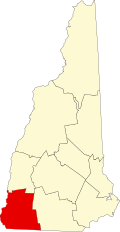Timothy Bancroft House | |
 | |
| Location | Bancroft Rd., Harrisville, New Hampshire |
|---|---|
| Coordinates | 42°57′54″N72°5′57″W / 42.96500°N 72.09917°W |
| Area | 1.5 acres (0.61 ha) |
| Built | 1785 |
| Architectural style | Greek Revival |
| MPS | Harrisville MRA |
| NRHP reference No. | 86003241 [1] |
| Added to NRHP | January 14, 1988 |
The Timothy Bancroft House is a historic house on Bancroft Road in Harrisville, New Hampshire. Located in a rural area once known as Mosquitoville, this c. 1785 wood-frame house was built by Timothy Bancroft, who operated a sawmill nearby that was one of the town's major industries for nearly a century. The house was listed on the National Register of Historic Places in 1988. [1]


